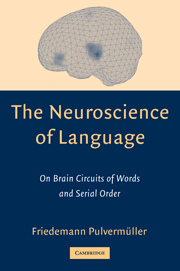Book contents
- Frontmatter
- Contents
- Preface
- The Neuroscience of Language
- 1 A Guide to the Book
- 2 Neuronal Structure and Function
- 3 From Classic Aphasia Research to Modern Neuroimaging
- 4 Words in the Brain
- Excursus E1 Explaining Neuropsychological Double Dissociations
- 5 Regulation, Overlap, and Web Tails
- 6 Neural Algorithms and Neural Networks
- 7 Basic Syntax
- 8 Synfire Chains as the Basis of Serial Order in the Brain
- 9 Sequence Detectors
- 10 Neuronal Grammar
- 11 Neuronal Grammar and Algorithms
- Excursus E2 Basic Bits of Neuronal Grammar
- Excursus E3 A Web Response to a Sentence
- 12 Refining Neuronal Grammar
- Excursus E4 Multiple Reverberation for Resolving Lexical Ambiguity
- Excursus E5 Multiple Reverberations and Multiple Center Embeddings
- 13 Neurophysiology of Syntax
- 14 Linguistics and the Brain
- References
- Abbreviations
- Author Index
- Subject Index
6 - Neural Algorithms and Neural Networks
Published online by Cambridge University Press: 15 December 2009
- Frontmatter
- Contents
- Preface
- The Neuroscience of Language
- 1 A Guide to the Book
- 2 Neuronal Structure and Function
- 3 From Classic Aphasia Research to Modern Neuroimaging
- 4 Words in the Brain
- Excursus E1 Explaining Neuropsychological Double Dissociations
- 5 Regulation, Overlap, and Web Tails
- 6 Neural Algorithms and Neural Networks
- 7 Basic Syntax
- 8 Synfire Chains as the Basis of Serial Order in the Brain
- 9 Sequence Detectors
- 10 Neuronal Grammar
- 11 Neuronal Grammar and Algorithms
- Excursus E2 Basic Bits of Neuronal Grammar
- Excursus E3 A Web Response to a Sentence
- 12 Refining Neuronal Grammar
- Excursus E4 Multiple Reverberation for Resolving Lexical Ambiguity
- Excursus E5 Multiple Reverberations and Multiple Center Embeddings
- 13 Neurophysiology of Syntax
- 14 Linguistics and the Brain
- References
- Abbreviations
- Author Index
- Subject Index
Summary
What does the investigation of artificial models of networks of neurons contribute to the investigation of brain function in general, and of language mechanisms in particular? There are at least two possible answers to this question.
One answer is that an artificial neural modelcan be used to prove that a circuit of a certain type can solve a given problem. When thinking about complex interactions of functional neuronal units, one is in danger of losing track of what a network actually can, and cannot, do. Here, a simulation may help by providing anexistence proof that a desired result can be obtained using a given circuitry or circuit structure. A successful simulation never proves that the network it is based on is actually realized in the nervous system; it shows only that the network type the simulation is based on is one candidate. To call it a realistic simulation, other criteria must be met: in particular, that the network structurecan be likened to brain structure and that the functional principles governing the neurons' behavior and their actual behavior haveanalogs in reality as well.
A second possible answer to the question about the significance of neuron models is that they can serve as illustrations of one's ideas about brain function. In the same way as a detailed verbal description or a description in terms of algorithms, a neuron circuit can help to make an idea more plastic.
- Type
- Chapter
- Information
- The Neuroscience of LanguageOn Brain Circuits of Words and Serial Order, pp. 96 - 123Publisher: Cambridge University PressPrint publication year: 2003



